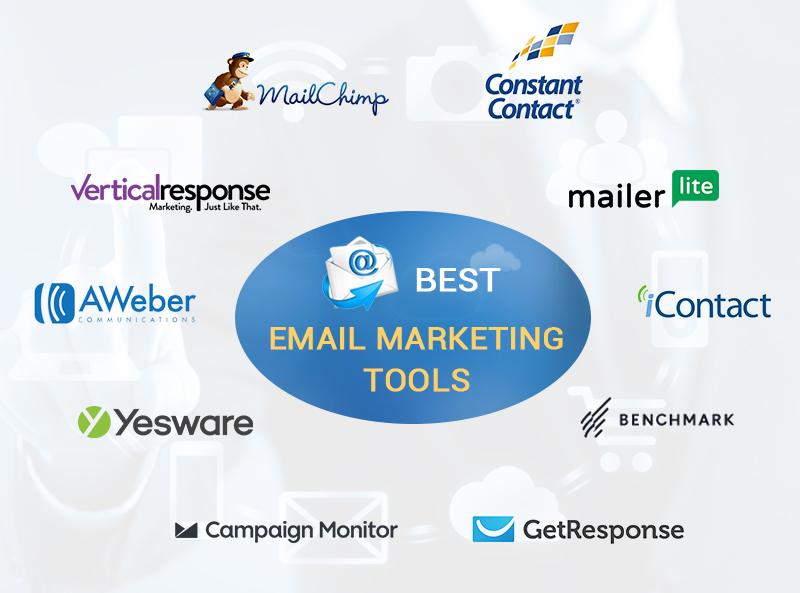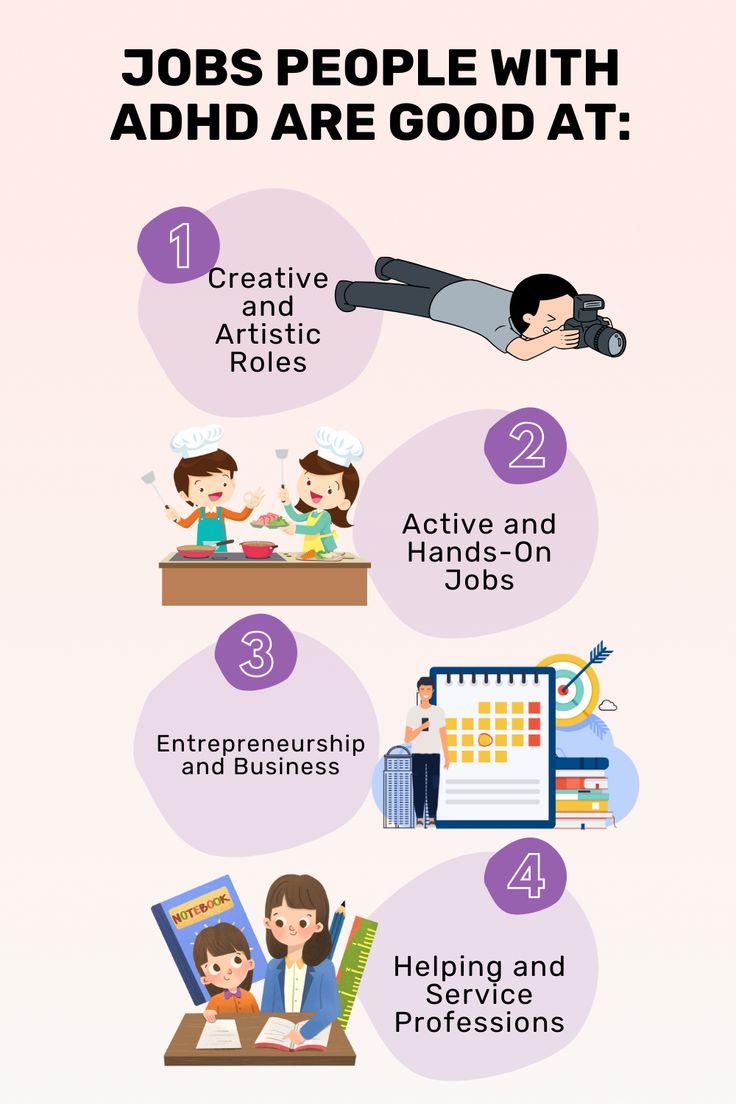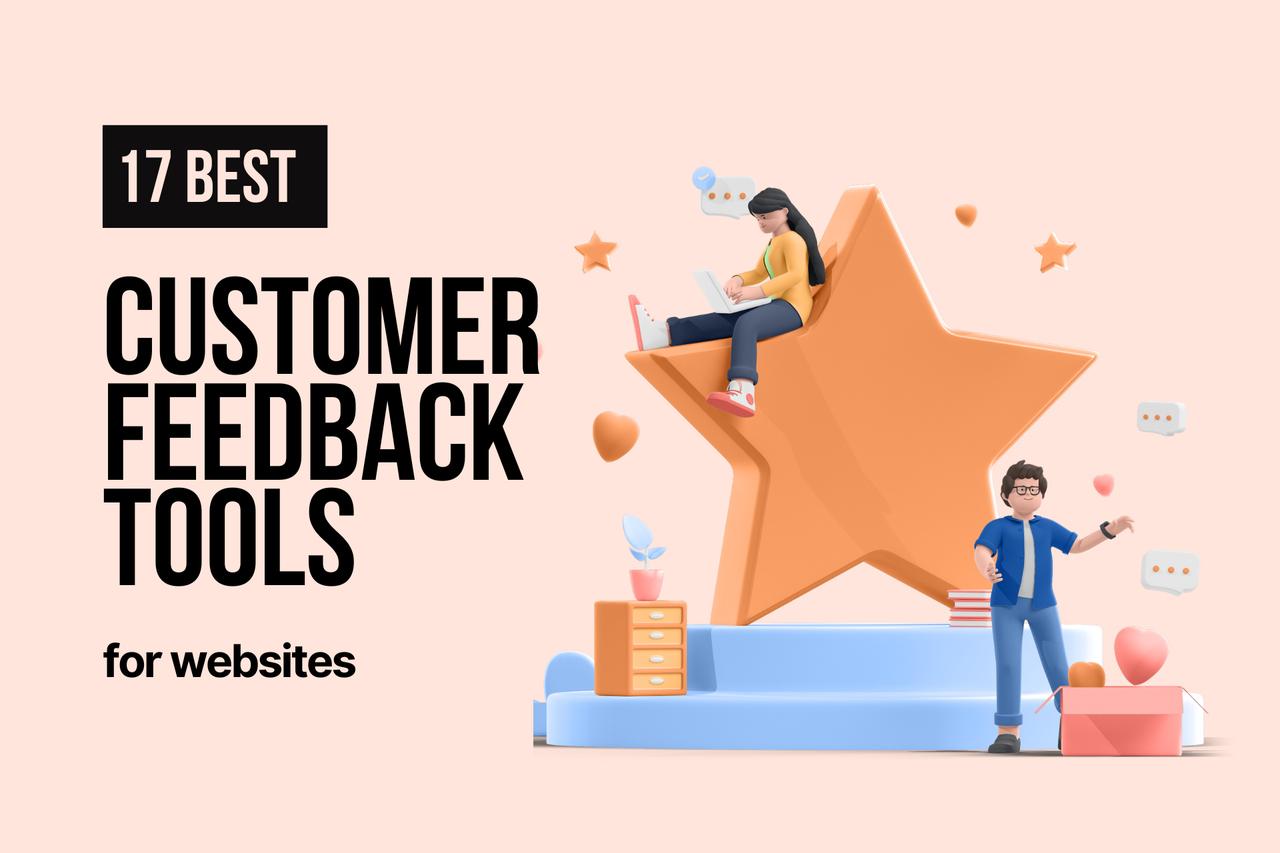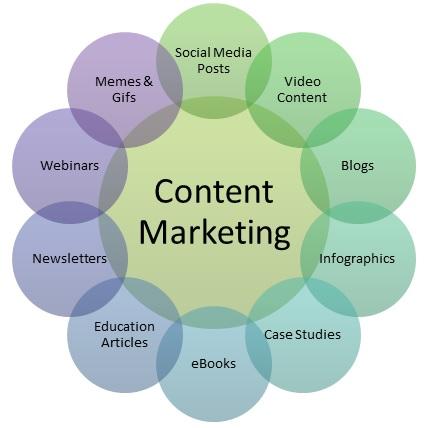
Are you ready to transform your content from mere words on a page to a powerful tool that drives conversions and grows your business? If so, you’re in the right place! In today’s digital landscape, creating content that not only engages your audience but also persuades them to take action is more crucial than ever. With countless brands vying for attention, standing out requires more than just great writing—it demands a strategic approach to content marketing.
In this article, we’ll explore 17 actionable tips that will help you craft compelling content that resonates with your audience and drives results. Whether you’re a seasoned marketer or just starting, these insights will empower you to create content that not only attracts eyeballs but also converts viewers into loyal customers. Let’s dive in and unlock the secrets to content that truly converts!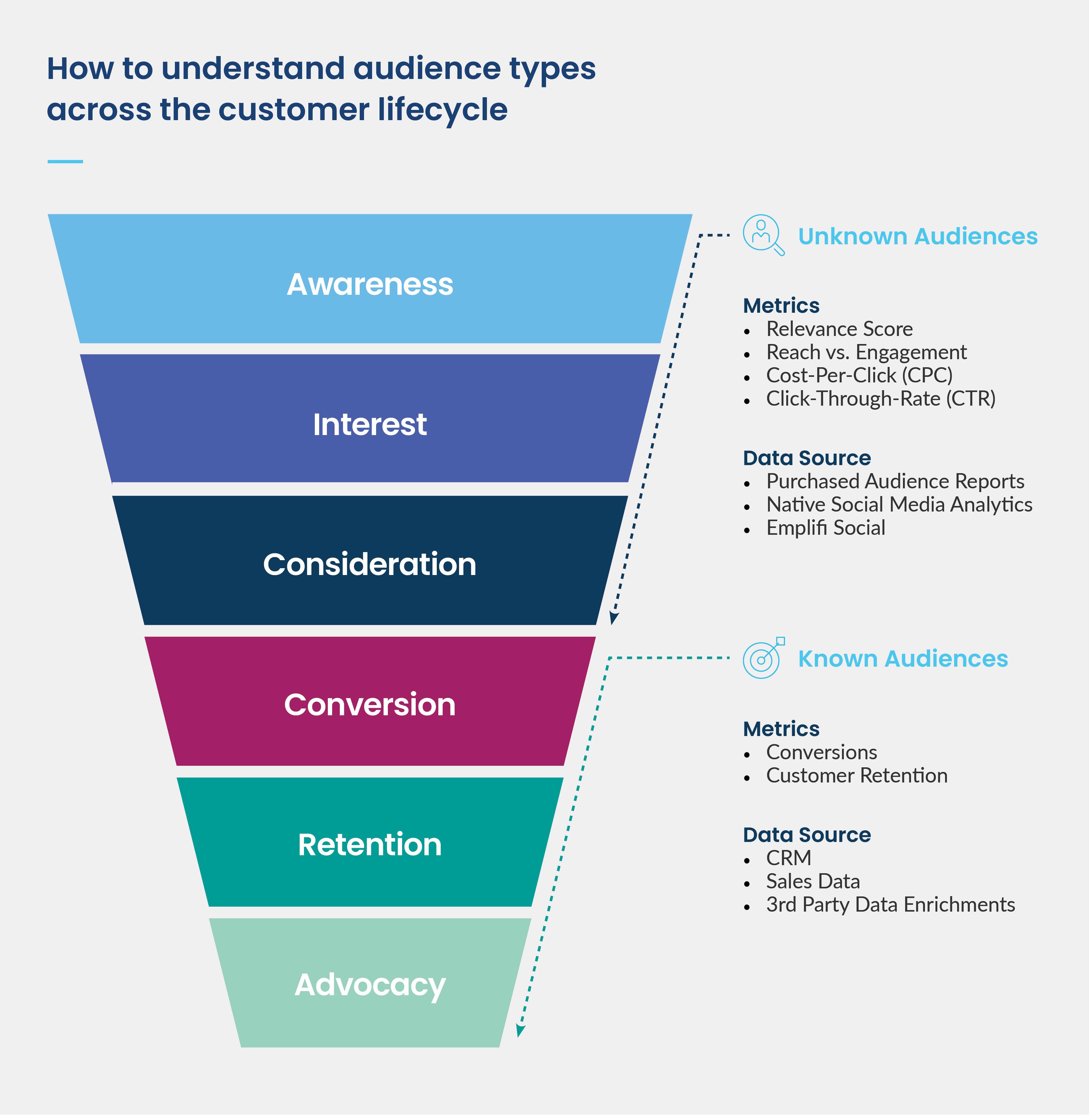
Understanding Your Audience for Effective Content Creation
Knowing who you’re speaking to is the cornerstone of successful content creation. Understanding your audience goes beyond basic demographics; it delves into their interests, challenges, and motivations. By tapping into these elements, you can tailor your content to resonate deeply with them, making your message not just heard, but felt.
Start by creating buyer personas. These are semi-fictional representations of your ideal customers based on real data and some educated assumptions. To build effective personas, consider the following:
- Demographics: Age, gender, location, education level
- Psychographics: Interests, values, lifestyle choices
- Pain Points: What problems do they face that your content can help address?
- Goals: What aspirations do they have that your content can help them achieve?
Once you have your personas, it’s crucial to engage with your audience directly. Conduct surveys, host interviews, or create polls on social media to gather insights. This direct feedback can provide invaluable context that shapes the way you create content that not only attracts but also converts your audience.
Another effective approach is to analyze your competitors. Look at the type of content that garners the most engagement in your niche. This can give you a sense of what resonates with similar audiences. However, avoid duplicating their efforts; instead, aim to carve out your unique voice and perspective.
Utilizing analytics tools can also provide you with rich insights into your audience’s behavior. Platforms like Google Analytics or social media insights can show you which types of content perform best, who is engaging with your content, and how they found you. This data is essential for adjusting your strategy to better meet audience needs.
Lastly, be sure to continually refine your understanding of your audience. Trends change, interests evolve, and new challenges arise. Regularly revisiting your personas and gathering feedback will ensure that your content remains relevant and engaging.
| Audience Insights | Content Strategies |
|---|---|
| Young professionals | Quick tips, career advice, and industry trends |
| Parents | Practical guides, parenting hacks, and emotional support |
| Small business owners | Case studies, how-tos, and networking opportunities |
Crafting Compelling Headlines That Grab Attention
In the crowded digital landscape, your headline is your first and often your only chance to make a lasting impression. A compelling headline can be the difference between a click and a scroll, so it’s crucial to get it right. Here are some strategies to create headlines that not only grab attention but also encourage readers to dive into your content.
- Use Numbers and Lists: Headlines with numbers tend to perform well because they promise concise and digestible information. For example, “5 Tips to Improve Your Content Strategy” immediately tells the reader they can expect a straightforward guide.
- Incorporate Power Words: Words like “Ultimate,” “Essential,” “Proven,” and “Secret” can evoke curiosity and urgency. For instance, “The Ultimate Guide to Content Marketing” suggests a comprehensive resource that shouldn’t be missed.
- Ask Questions: Posing a question in your headline can engage readers’ minds right away. Something like, “Are You Making These Common Content Mistakes?” invites introspection and encourages clicks.
- Create a Sense of Urgency: Headlines that imply urgency can spur immediate action. Phrases like “Don’t Miss Out” or “Limited Time Offer” can motivate readers to click now rather than later.
Another effective tactic is using emotional triggers. Headlines that evoke emotions can draw readers in, making them feel connected to the content even before they read it. Whether it’s excitement, fear, or curiosity, tapping into these feelings can significantly boost your headline’s effectiveness.
| Emotional Trigger | Example Headline |
|---|---|
| Fear | “Are You Making These Costly Marketing Mistakes?” |
| Curiosity | “What Most Content Marketers Won’t Tell You” |
| Excitement | “Discover the Secrets to Viral Content” |
| Surprise | “This One Simple Trick Will Change Your Content Strategy” |
Lastly, don’t underestimate the power of clarity and specificity. A clear headline allows readers to understand what they will gain from your content. Instead of vague descriptions, opt for specific benefits, such as “Learn How to Double Your Engagement Rate in 30 Days.” This not only informs but also entices readers who are looking for tangible results.
Experimentation is key when it comes to crafting headlines. Test different variations to see which resonates most with your audience. Utilize A/B testing methods where possible, as this can provide valuable insights into what types of headlines are most effective for your specific audience.

The Power of Storytelling in Content Marketing
In the world of content marketing, storytelling isn’t just a technique; it’s a powerful strategy that can transform your engagement levels and drive conversions. When brands weave narratives into their content, they create emotional connections that resonate with audiences. This connection is the spark that ignites interest and loyalty, turning casual readers into devoted customers.
Why Stories Matter
Stories have a unique ability to captivate and hold attention. Here’s why they are crucial in content marketing:
- Emotional Engagement: Stories evoke emotions, making your message more relatable and memorable.
- Brand Personality: A well-told story can personify your brand, showcasing its values and mission in a way that facts alone cannot.
- Information Retention: Our brains are wired to remember stories better than dry statistics or data. A good narrative sticks with your audience long after they’ve consumed the content.
Crafting Compelling Narratives
To harness the power of storytelling, start by identifying the key elements that make a story captivating:
- Character Development: Your audience should see themselves in your stories. Use relatable characters who face challenges and triumphs that reflect your audience’s experiences.
- Conflict and Resolution: Every good story has conflict. Present a problem relevant to your audience and show how your product or service offers a solution.
- Emotionally Charged Language: Use descriptive language that evokes feelings. Paint a vivid picture with your words to draw readers into the narrative.
The Structure of a Great Story
Utilizing a classic story structure can significantly enhance your content. Consider this framework:
| Story Element | Description |
|---|---|
| Beginning | Introduce the character and the setting, establishing a relatable context. |
| Middle | Present the conflict or challenge that sparks the journey. |
| End | Show the resolution, ideally highlighting how your product/service plays a crucial role. |
Incorporating Storytelling in Various Formats
Don’t limit your storytelling to just blog posts. Consider using a variety of formats to reach and engage your audience:
- Videos: Story-driven video content can enhance visual engagement and share your narrative more dynamically.
- Podcasts: Use audio storytelling to connect with audiences on a personal level, allowing them to consume your content on the go.
- Social Media: Short stories or snippets can be shared on platforms like Instagram or Twitter to create buzz and drive traffic.
Conclusion
Integrating storytelling into your content marketing strategy is not just about being creative; it’s about effectively communicating your brand’s message in a way that resonates. By doing so, you can inspire action, build relationships, and ultimately, boost your conversion rates. Remember, every great brand has a story—what’s yours?
Incorporating SEO Best Practices for Greater Reach
To effectively enhance the visibility of your content, integrating SEO best practices is essential. When crafting your articles or blog posts, consider the following strategies to maximize your reach:
- Keyword Research: Identify relevant keywords that your target audience is searching for. Use tools like Google Keyword Planner or Ahrefs to find terms with high search volume and low competition.
- On-Page Optimization: Ensure that your keywords are strategically placed in titles, headers, and throughout the content. Remember, it’s not just about stuffing keywords but making them fit naturally within your narrative.
- Meta Descriptions: Write compelling meta descriptions that include your target keywords. A well-crafted meta description can significantly improve your click-through rate from search engine results.
- Internal Linking: Build a robust internal linking strategy. Linking to other relevant posts on your site can keep readers engaged longer and improve your site’s overall SEO performance.
Another critical aspect of SEO is ensuring your content is easily shareable. Implement social sharing buttons to encourage readers to promote your content on their networks. Consider the following:
- Visual Appeal: Create eye-catching graphics, infographics, and videos that complement your written content. Engaging visuals can significantly enhance shareability.
- Call-to-Action (CTA): Include strong CTAs that prompt users to share your content or subscribe to your newsletter. This interaction can amplify your reach exponentially.
Moreover, pay attention to the technical aspects of your website. A well-optimized site not only benefits your users but also enhances search engine ranking. Here are a few technical tips:
| Technical SEO Tips | Description |
|---|---|
| Mobile Optimization | Ensure your site is mobile-friendly, as more people are browsing on their phones. |
| Site Speed | Optimize images and use caching to improve loading times. |
| XML Sitemap | Create an XML sitemap to help search engines crawl your site more effectively. |
| SSL Certificate | Implement HTTPS to secure your site, which is favored by search engines. |
Lastly, keep an eye on your analytics. Use tools like Google Analytics and SEMrush to track performance. Monitor which strategies yield the best results and adjust your tactics accordingly. By regularly updating your content and optimizing for SEO, you can create a sustainable flow of traffic that continually converts.
Utilizing Visuals to Enhance Engagement and Retention
Visual content is not just an accessory in your marketing strategy; it’s a vital element that can significantly boost user engagement and information retention. When it comes to crafting compelling content, images, infographics, and videos should be your best friends. They not only break up text but also help to illustrate concepts that might otherwise be difficult to convey through words alone.
One of the main benefits of incorporating visuals is their ability to capture attention quickly. Studies show that people are more likely to remember information when it’s paired with relevant images. This phenomenon, known as the “picture superiority effect,” means that your audience is more likely to recall your message if it’s accompanied by striking visuals. So, if you want your content to stick in the minds of your readers, visuals are essential.
Moreover, visuals can improve the overall user experience on your site. A well-designed infographic can simplify complex data, presenting it in a format that is not only easier to digest but also more enjoyable. Consider the following ways to implement visuals effectively:
- Infographics: These are perfect for summarizing statistics and presenting data in a visually appealing way.
- Videos: Engaging video content can boost dwell time and keep your audience glued to your message longer.
- Images: High-quality, relevant images enhance storytelling and evoke emotions, making your content more relatable.
To get the most out of your visuals, you should also consider the placement and context. Inserting an infographic in the middle of a long article can break the monotony and give your readers a visual rest. Meanwhile, strategically placed videos can serve as a dynamic introduction or conclusion to your content, reinforcing your key messages.
Here’s a quick reference table that showcases the advantages of various types of visual content:
| Visual Type | Benefits |
|---|---|
| Images | Enhance storytelling, evoke emotions |
| Infographics | Simplify data, increase shareability |
| Videos | Boost engagement, increase dwell time |
don’t forget about optimization. Just as with text, your visuals should be optimized for SEO. Use descriptive file names and alt tags, and ensure that your images are sized appropriately for fast loading times. This not only helps with your search visibility but also contributes to a better user experience.
Incorporating effective visuals into your content strategy can drive engagement and retention rates like never before. So, don’t underestimate the power of a well-placed image or an engaging video; they can be the key to transforming casual readers into loyal followers.
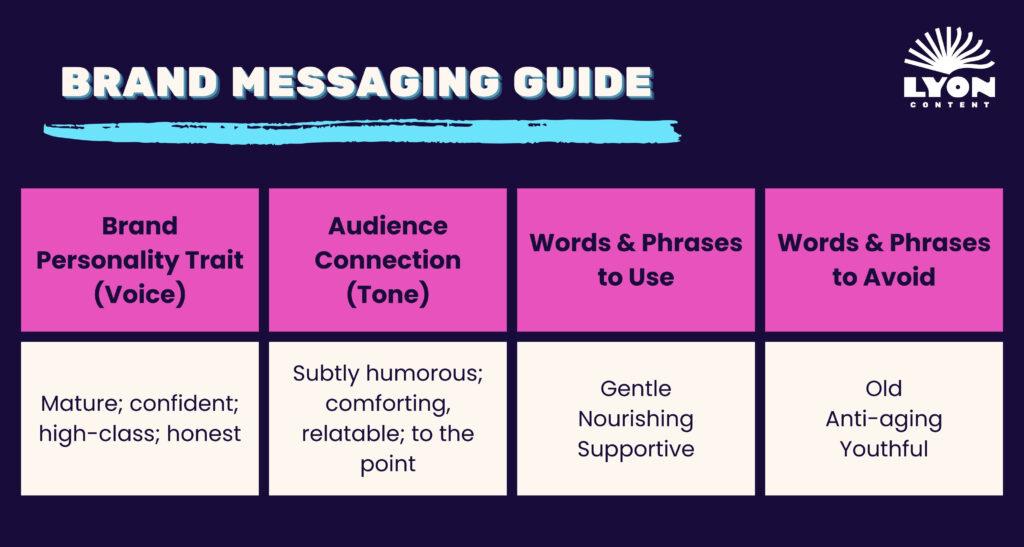
Creating a Consistent Brand Voice Across All Channels
When it comes to building a recognizable identity for your brand, consistency is key. Your brand voice should resonate well across all platforms, whether it’s on social media, your website, or email campaigns. A unified voice not only strengthens your brand’s presence but also fosters trust and loyalty among your audience.
To achieve this, start by defining your brand’s personality. Ask yourself questions like:
- What are the core values of my brand?
- How do I want my audience to perceive my brand?
- What emotions do I want to evoke through my messaging?
Once you have a clear understanding of your brand’s personality, create a brand voice guide. This guide should encapsulate:
- Tone and style: Should your brand sound professional, friendly, quirky, or authoritative?
- Vocabulary: Identify specific words or phrases that resonate with your audience and reflect your brand’s character.
- Grammar and punctuation rules: Decide if you’ll use contractions, slang, or industry jargon.
Here’s a simple comparison table to illustrate how different tones can affect your messaging:
| Brand Aspect | Friendly Tone | Professional Tone |
|---|---|---|
| Greeting | Hey there! 👋 | Welcome. |
| Information | Let’s dive into this exciting topic! | This report outlines the necessary data. |
| Closing | Catch you later! | Thank you for your attention. |
After establishing your guidelines, it’s essential to train your team. Everyone who creates content for your brand should understand and embody the voice you want to project. Hold workshops, share examples, and encourage feedback to ensure everyone is on the same page.
consistency doesn’t mean rigidity. Be adaptable to the platform you’re using. While maintaining your core voice, adjust the nuances according to the audience and context. For instance, your website may require a more formal tone, while social media can be more casual and engaging. Balance is crucial.
By following these steps, you’ll create a lasting impression that not only attracts attention but also converts visitors into loyal customers. Remember, a compelling and consistent brand voice is your secret weapon in the crowded digital landscape.

Leveraging User-Generated Content for Authenticity
In today’s digital landscape, where consumers are bombarded with messages from brands, authenticity has become a key differentiator. One powerful way to achieve this authenticity is by leveraging user-generated content (UGC). UGC not only showcases real experiences but also builds trust among potential customers, as it reflects genuine interactions with your brand. Here’s how to effectively harness the power of user-generated content.
First and foremost, encourage your audience to share their experiences. This can be as simple as creating a branded hashtag for social media platforms. By doing so, you invite users to share photos, videos, or testimonials related to your products or services. To incentivize participation, consider running contests or giveaways that reward users for their contributions. This not only boosts engagement but also expands your reach as more people share their content.
Once you start receiving UGC, don’t be shy about showcasing it. Highlighting customer stories or reviews on your website or social media channels can significantly enhance your credibility. You can create a dedicated section on your site for testimonials or a gallery for user photos. This displays your product in a real-world context, allowing potential customers to envision how they might engage with your brand.
Additionally, you can create a sense of community around your brand by featuring user-generated content regularly. This could involve sharing a “Customer of the Month” story or curating a weekly roundup of the best social media posts featuring your products. This not only honors your customers but also encourages others to participate, knowing their contributions could be spotlighted as well.
To further amplify the impact of UGC, consider collaborating with influencers or micro-influencers in your niche. These individuals can help promote your branded content, encouraging their followers to share their own experiences with your products. This creates a ripple effect, generating even more authentic content while expanding your brand’s reach and visibility.
| Benefits of UGC | Examples |
|---|---|
| Builds Trust | Testimonials, Reviews |
| Enhances Engagement | Contests, Hashtags |
| Creates Community | Spotlight Features, User Stories |
| Increases Reach | Influencer Collaborations |
always remember to give credit where credit is due. When sharing user-generated content, tag and acknowledge the creators. This not only fosters goodwill but also encourages more users to contribute, knowing their efforts will be appreciated and recognized. By integrating UGC into your content marketing strategy, you’re not just promoting a product; you’re creating a movement built on real connections and authentic experiences.

Building a Content Calendar to Stay Organized and Consistent
Creating a content calendar is like drawing a roadmap for your content marketing journey. It helps you visualize your goals, plan your topics, and stay on track with your publishing schedule. Here’s how to build a content calendar that keeps you organized and consistent.
First, choose a format that works best for you. Some prefer digital tools like Google Calendar or Trello, while others may opt for a simple spreadsheet or a physical planner. The key is to select a format that you find easy to use and can access regularly.
Next, establish a timeline. Consider how often you want to publish content—this could be daily, weekly, or monthly. Whatever the frequency, make sure it’s realistic based on your resources. Consistency is crucial, as it builds audience expectations and keeps your brand top-of-mind.
Here are some essential elements to include in your content calendar:
- Publishing Dates: Clearly mark when each piece of content will go live.
- Content Types: Specify whether it’s a blog post, video, podcast, or social media update.
- Topics/Titles: Jot down ideas or working titles for each piece.
- SEO Keywords: Include primary and secondary keywords to optimize your content.
- Assigned Roles: Note who is responsible for writing, editing, and publishing.
To give you an idea, here’s a simple table layout for your calendar:
| Publication Date | Content Type | Topic/Title | SEO Keywords | Assigned To |
|---|---|---|---|---|
| 01/15/2023 | Blog Post | Building a Content Calendar | content calendar, marketing strategy | Jane Doe |
| 01/22/2023 | Video | Top 5 Content Tips | content tips, video marketing | John Smith |
Once you have the structure in place, start brainstorming content ideas. Think about your audience’s pain points, interests, and questions. Use tools like Google Trends or social media analytics to identify topics that resonate with your target market.
Lastly, remember that your content calendar isn’t set in stone. It should be a living document that you revisit and adjust as necessary. Keep an eye on performance metrics and be flexible enough to adapt to trends or popular topics that arise.
With a well-thought-out content calendar, you’ll find it much easier to maintain consistency and organization in your content marketing efforts. This not only enhances your productivity but also ensures that your audience receives valuable content on a regular basis.
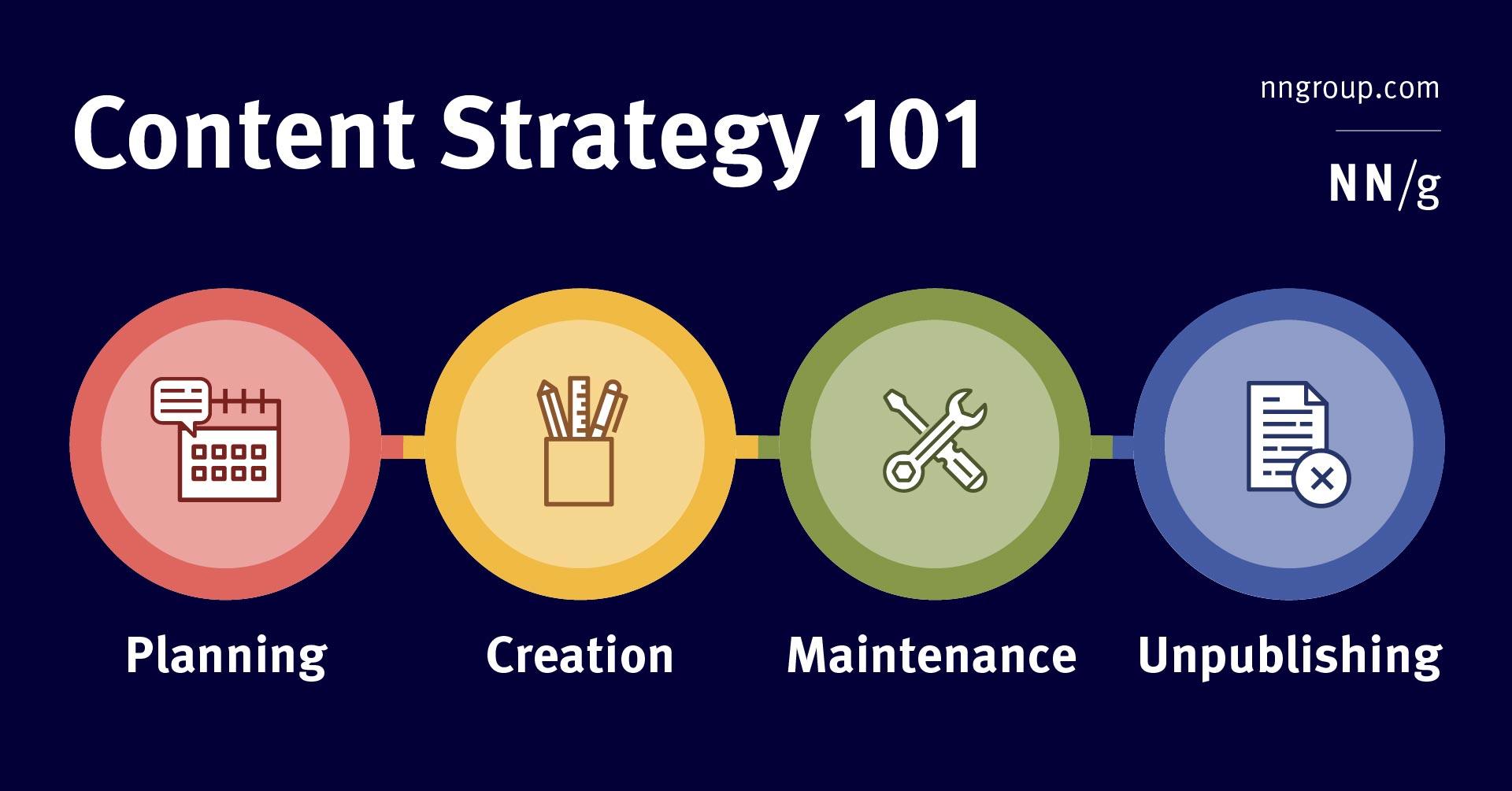
Analyzing Metrics to Refine Your Content Strategy
In today’s digital landscape, measuring the effectiveness of your content is crucial for success. By analyzing various metrics, you can gain valuable insights that inform your content strategy and enhance your overall marketing efforts. Here are some key metrics to focus on:
- Traffic Sources: Understanding where your traffic comes from helps you identify which channels are most effective. Are your visitors finding you through organic search, social media, or referrals? This knowledge allows you to allocate resources efficiently.
- Engagement Rates: Metrics like time on page, bounce rate, and comments can reveal how well your audience is connecting with your content. High engagement rates typically indicate that your content resonates with your audience, while low rates may suggest a need for reevaluation.
- Conversion Rates: Ultimately, the goal of your content is to drive conversions. Analyze how many visitors take action after consuming your content. Whether it’s signing up for a newsletter or making a purchase, tracking conversions can help you refine your approach.
One effective way to visualize and compare your metrics is through tables. Here’s a simple layout to help you track your performance:
| Metric | Current Value | Target Value | Action Needed |
|---|---|---|---|
| Traffic Sources | 60% Organic | 70% Organic | Increase SEO efforts |
| Engagement Rate | 3 minutes | 5 minutes | Revise content length |
| Conversion Rate | 2% | 5% | Improve CTA designs |
Additionally, consider segmenting your audience based on their interactions with your content. For instance, creating personas that represent your ideal customers can help tailor your content to meet their specific needs and preferences.
Furthermore, utilize A/B testing to explore different versions of your content. Experiment with various headlines, images, and formats to determine what resonates best with your audience. By continuously testing and analyzing results, you can make data-driven decisions that enhance your content strategy.
Lastly, don’t forget to keep an eye on social media metrics. Shares, likes, and comments can provide insight into how your content is perceived externally. By monitoring these interactions, you can refine your approach to align better with what your audience finds shareable and engaging.
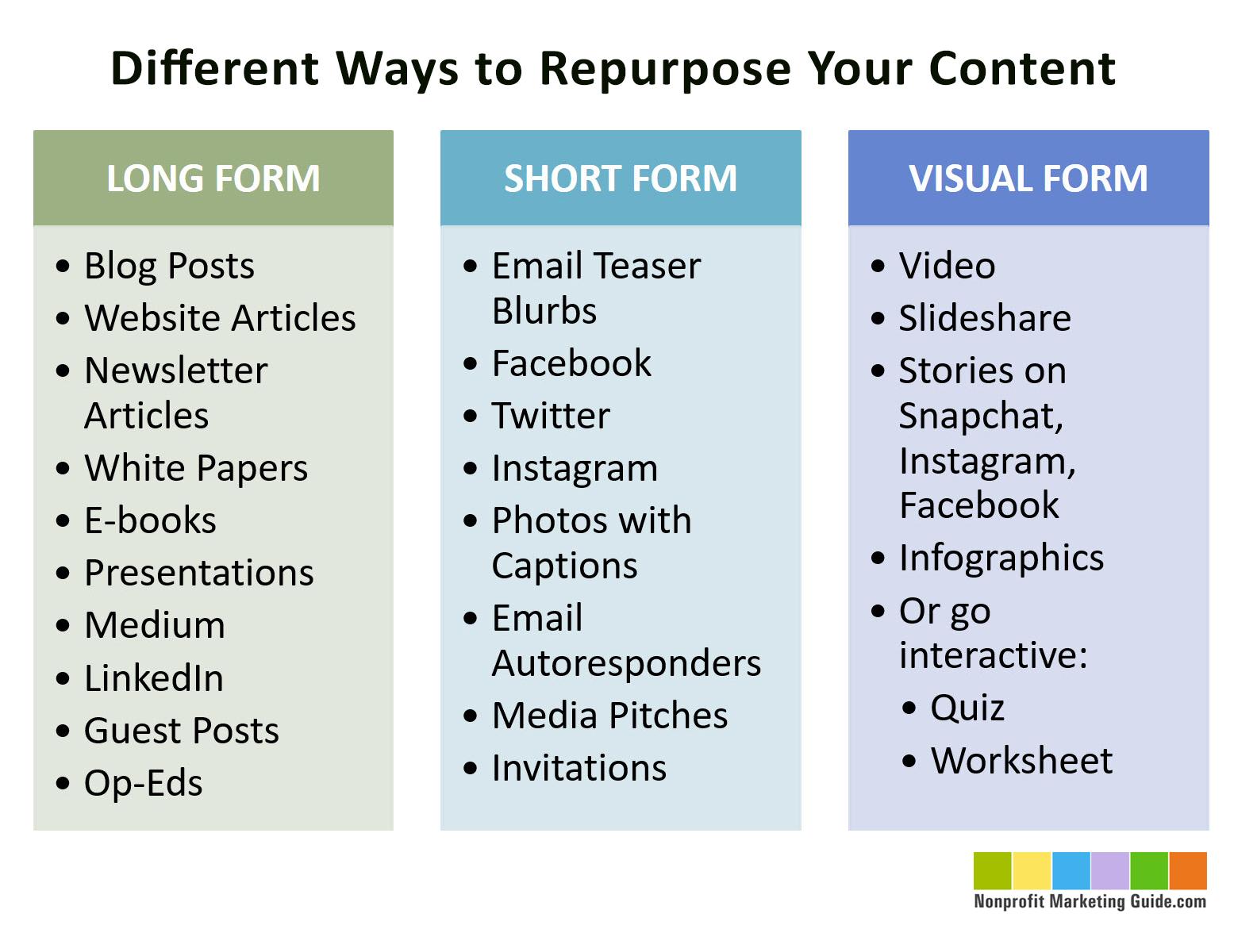
Repurposing Content to Maximize Value and Reach
In the dynamic world of content marketing, one of the smartest strategies to amplify your reach and enhance value is through repurposing your existing content. This not only saves time and resources but also allows your audience to engage with your material in various formats that suit their preferences.
Imagine transforming a single blog post into multiple forms of content. Here are some innovative ways to repurpose:
- Infographics: Summarize key points from your articles into visually appealing graphics that can be shared on social media.
- Podcasts: Convert the essence of your written content into an engaging audio format, allowing listeners to absorb information on the go.
- Videos: Create short video clips or tutorials that encapsulate the main ideas, capturing the attention of visual learners.
- Slide Presentations: Use platforms like SlideShare to present your content in a dynamic, easy-to-digest format that’s perfect for professional audiences.
Additionally, consider creating a content series. Break down a larger topic into smaller, digestible pieces that keep your audience eagerly anticipating the next installment. This method not only builds engagement but also encourages deeper exploration of your subject matter.
When it comes to social media, don’t underestimate the power of snippets and quotes. Pull out compelling lines or statistics from your content to create shareable posts. These bite-sized pieces of information can drive traffic back to your original content, expanding your reach significantly.
Another effective strategy is to utilize email newsletters. Curate a collection of your best-performing content, along with fresh insights, to keep your audience informed and engaged. This not only showcases your expertise but also drives traffic back to your website.
| Content Type | Purpose | Best Platforms |
|---|---|---|
| Blog Posts | In-depth analysis | Your Website |
| Infographics | Visual storytelling | Pinterest, Instagram |
| Podcasts | Auditory engagement | Apple Podcasts, Spotify |
| Videos | Visual and auditory learning | YouTube, TikTok |
| Social Media Posts | Quick engagement | Facebook, Twitter |
always remember to analyze the performance of your repurposed content. Use analytics tools to track metrics such as engagement rates and traffic generation. This data will help you understand what formats resonate best with your audience, allowing you to refine your strategy for maximum impact.

Encouraging Social Sharing to Expand Your Audience
To significantly extend your reach and cultivate a loyal audience, harnessing the power of social sharing is essential. By encouraging your readers to share your content, you not only amplify your message but also create a sense of community among your followers. Here are some effective strategies to promote social sharing:
- Optimize for Social Media: Ensure that your content is easily shareable. Use plugins and tools that automatically generate social sharing buttons. The more accessible the sharing options, the more likely your audience will spread the word.
- Create Engaging Visuals: Eye-catching images and infographics can significantly boost your shareability. Visual content tends to get more engagement on social media platforms, making it crucial to include high-quality visuals in your posts.
- Incorporate Shareable Quotes: Pull out compelling quotes from your content. These bite-sized nuggets can be easily shared on platforms like Twitter and Instagram, encouraging your audience to share their favorite insights from your work.
- Craft Compelling Calls to Action: Don’t be shy about asking your readers to share your content! A simple, friendly prompt at the end of your post can motivate your audience to spread the word.
Additionally, understanding the psychology behind sharing can enhance your strategies. People share content for various reasons: to express themselves, to provide value to others, or to stay connected with their network. Tailoring your content to appeal to these motivations can lead to increased sharing.
Consider creating content that resonates on a personal level. This could be through storytelling or by addressing common pain points. When readers find content relatable, they are more inclined to share it with their own networks, boosting your visibility.
| Reason for Sharing | How to Encourage It |
|---|---|
| Self-Expression | Encourage sharing of personal insights and experiences. |
| Value Addition | Create informative content that readers want to share with others. |
| Connection | Craft content that sparks conversation and community engagement. |
tracking your social sharing metrics is vital. Use analytics tools to understand which content performs best on social platforms. This data can inform future content strategies, guiding you to create materials that not only engage but also resonate with your audience, encouraging even more shares.

Implementing Strong Calls-to-Action That Drive Conversions
Creating effective calls-to-action (CTAs) is essential for guiding your audience toward the next steps in their journey. To ensure your CTAs resonate and drive conversions, it’s important to focus on several key elements.
Clarity is Crucial. Your CTA should leave no room for confusion. Use clear, straightforward language that tells your audience exactly what action you want them to take. For example, instead of saying “Click here,” try “Download your free e-book now.” This not only informs them about the action but also adds value.
Make It Visually Stand Out. Incorporating contrasting colors, bold fonts, and ample whitespace can make your CTA more eye-catching. Consider using buttons instead of plain text links, as they naturally draw the eye and encourage clicks. Ensure your design aligns with your brand for consistency while still standing out on the page.
Create a Sense of Urgency. Encouraging immediate action can significantly boost conversion rates. Phrases like “Limited time offer” or “Join now and save 20%” can prompt users to act rather than delaying their decision. However, be careful not to overuse urgency; it should feel authentic and not forced.
Use Action-Oriented Language. The words you choose matter immensely. Strong verbs like “Get,” “Start,” “Join,” or “Discover” can create a compelling urgency that motivates your audience. Pair these action words with benefits to effectively communicate what’s in it for them.
Test and Optimize. Regularly experiment with different variations of your CTAs to see what resonates best with your audience. A/B testing can help you determine which wording, colors, or placements yield the highest conversion rates. Keep analyzing the data and refine your CTAs based on performance metrics.
| CTA Element | Best Practices |
|---|---|
| Language | Use clear, direct phrases |
| Design | Utilize contrasting colors and buttons |
| Urgency | Incorporate limited-time offers |
| Testing | Conduct A/B tests frequently |
don’t forget to position your CTAs strategically within your content. Placing them at the end of a blog post, within the flow of the article, or even as pop-ups can provide multiple opportunities for engagement. Each placement can cater to different reading habits, increasing the likelihood of conversions.
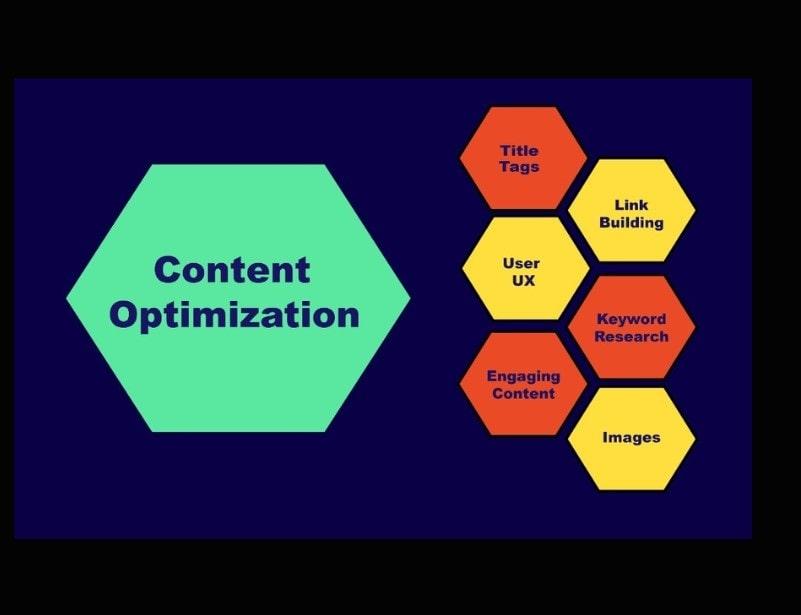
Testing and Optimizing Your Content for Better Performance
When it comes to content creation, the journey doesn’t end once you hit publish. In fact, that’s just the beginning. Testing and optimizing your content can significantly enhance its performance and engagement rates. It’s about understanding what resonates with your audience and making necessary adjustments to ensure your message is both compelling and effective.
Start by implementing A/B testing on your headlines and calls to action. This method allows you to compare two versions of a piece of content to see which performs better. You can experiment with:
- Headlines: Test different phrasing, lengths, and emotional triggers.
- Formats: Try using lists versus paragraphs or incorporating images.
- Calls to Action (CTAs): Adjust the wording and positioning to see what drives more clicks.
Another key aspect is to analyze your content’s performance through various metrics. Utilize tools like Google Analytics to track:
- Traffic Sources: Understand where your visitors are coming from.
- Bounce Rates: Identify content that doesn’t keep your audience engaged.
- Conversion Rates: Measure how effectively your content drives actions.
It’s also essential to keep an eye on SEO performance. Regularly update your content to ensure it remains relevant and optimized for search engines. Use tools like SEMrush or Ahrefs to track keyword rankings and make adjustments based on what’s trending in your niche.
| Content Element | Optimization Strategy |
|---|---|
| Headlines | Use power words and keep it under 60 characters. |
| Images | Optimize file sizes and use alt text for SEO. |
| Links | Incorporate internal and relevant external links. |
Don’t forget to ask for feedback from your audience. Engaging with readers through comments, polls, or surveys can provide invaluable insights into what they love or dislike about your content. This direct feedback loop is crucial for continual improvement.
Ultimately, the goal of testing and optimizing is to create a seamless experience for your audience. By regularly reviewing and refining your content, you not only maintain relevance but also build trust with your readers, turning casual visitors into loyal followers.

Staying Updated on Trends to Keep Content Fresh and Relevant
In the fast-paced world of content marketing, staying on top of trends is crucial for maintaining a competitive edge. Your audience’s preferences evolve, and so should your content. To ensure your material remains engaging and relevant, consider the following strategies:
- Follow Industry Leaders: Subscribe to newsletters, podcasts, and blogs from key influencers in your niche. They often share insights into emerging trends and best practices that can inspire your own content.
- Utilize Social Media: Platforms like Twitter, LinkedIn, and Instagram are excellent for gauging real-time trends. Monitor hashtags and trending topics to see what’s resonating with your audience.
- Engage with Your Audience: Pay attention to comments, messages, and feedback on your posts. Your audience’s conversations can provide valuable clues about what they find interesting and relevant.
- Leverage Google Trends: This tool allows you to see what people are searching for in real-time. Use these insights to tailor your content to current interests and questions in your niche.
Incorporating fresh ideas into your content doesn’t have to be daunting. Consider creating a content calendar that emphasizes trending topics. Here’s a simple example:
| Week | Theme | Content Type |
|---|---|---|
| 1 | Current Events | Blog Post |
| 2 | Industry Innovations | Infographic |
| 3 | Audience Q&A | Video |
| 4 | Monthly Roundup | Newsletter |
Don’t forget to tap into user-generated content. Encourage your audience to share their thoughts, photos, or experiences related to your brand. This not only increases engagement but also provides you with authentic content that reflects current trends and interests.
Lastly, keep an eye on your competitors. Analyze their content strategies to identify gaps in your own. Tools like SEMrush or BuzzSumo can help you discover what types of content are performing well in your industry. Remember, while it’s important to stay informed, don’t feel pressured to follow every trend. Choose those that align with your brand values and resonate with your audience.
By embracing a proactive approach to trend monitoring, you’ll ensure your content remains not just fresh, but also deeply relevant to your audience’s needs and interests.
Frequently Asked Questions (FAQ)
Q&A: 17 Content Marketing Tips: How to Create Content That Converts
Q1: What is content marketing, and why should I care about it?
A1: Great question! Content marketing is all about creating valuable, relevant content to attract and engage your target audience. It’s not just about selling; it’s about building relationships and trust. In today’s digital world, effective content marketing can significantly influence buying decisions, helping you convert leads into loyal customers. So, if you want to grow your business, you can’t afford to ignore it!
Q2: How do I start creating content that actually converts?
A2: Start by understanding your audience. What are their pain points, interests, and preferences? Use this knowledge to create content that addresses their needs. It’s all about offering solutions! And remember, storytelling is a powerful tool. It draws people in and makes your message relatable. So, find your narrative and let it shine!
Q3: What types of content should I focus on?
A3: Diversifying your content types can really boost engagement. Think blog posts, infographics, videos, podcasts, and social media updates. Each type serves a different purpose and can cater to various segments of your audience. But don’t forget the importance of high-quality, well-researched content—no matter the format, it should always provide value!
Q4: How can I optimize my content for search engines?
A4: Ah, SEO is essential! Start by conducting keyword research to find the terms your audience is searching for. Use these keywords naturally in your content, headings, and meta descriptions. But remember, while SEO is crucial, your primary focus should always be on providing value to your readers. If you create great content, it will naturally attract traffic over time!
Q5: How often should I publish new content?
A5: Consistency is key! Whether it’s once a week, bi-weekly, or monthly, establish a schedule that you can maintain. Regularly publishing content keeps your audience engaged and hungry for more. Plus, it signals to search engines that your site is active, which can help improve your rankings. Find a rhythm that works for you and stick to it!
Q6: What’s the role of social media in content marketing?
A6: Social media is a powerhouse for content distribution! It allows you to reach a broader audience and engage with your followers in real-time. Share your content, interact with your audience, and encourage them to share it too. This not only amplifies your message but also helps build a community around your brand. Don’t underestimate the power of social sharing!
Q7: How do I measure the success of my content?
A7: You’ll want to look at various metrics, such as traffic, engagement rates, conversion rates, and social shares. Tools like Google Analytics can help you track these metrics effectively. Pay attention to what works and what doesn’t, and adjust your strategy accordingly. Experimentation is part of the game—don’t be afraid to tweak things until you find your sweet spot!
Q8: Any final tips for creating content that converts?
A8: Absolutely! Always include a clear call to action (CTA) in your content. Whether it’s signing up for a newsletter, downloading a resource, or making a purchase, guide your audience on what to do next. And don’t forget to keep testing and iterating your content based on feedback and performance. Content marketing is a journey—stay persistent, and the results will follow!
By following these tips, you’ll be well on your way to creating content that not only captivates your audience but also drives conversions. Happy content creating!
In Conclusion
And there you have it—17 powerful content marketing tips that can transform your approach to creating content that truly converts! Remember, it’s not just about churning out articles or social media posts; it’s about crafting engaging, valuable content that resonates with your audience and drives action.
Take these strategies and weave them into your content creation process. Experiment, analyze, and don’t be afraid to tweak your approach based on what your audience responds to. The beauty of content marketing is that it’s an ever-evolving landscape, and your willingness to adapt will set you apart from the competition.
So, what are you waiting for? Start implementing these tips today and watch your content work harder for you! If you found this article helpful, share it with friends or colleagues who could use a boost in their content strategy. Let’s create content that not only captures attention but also converts—together! Happy creating!




